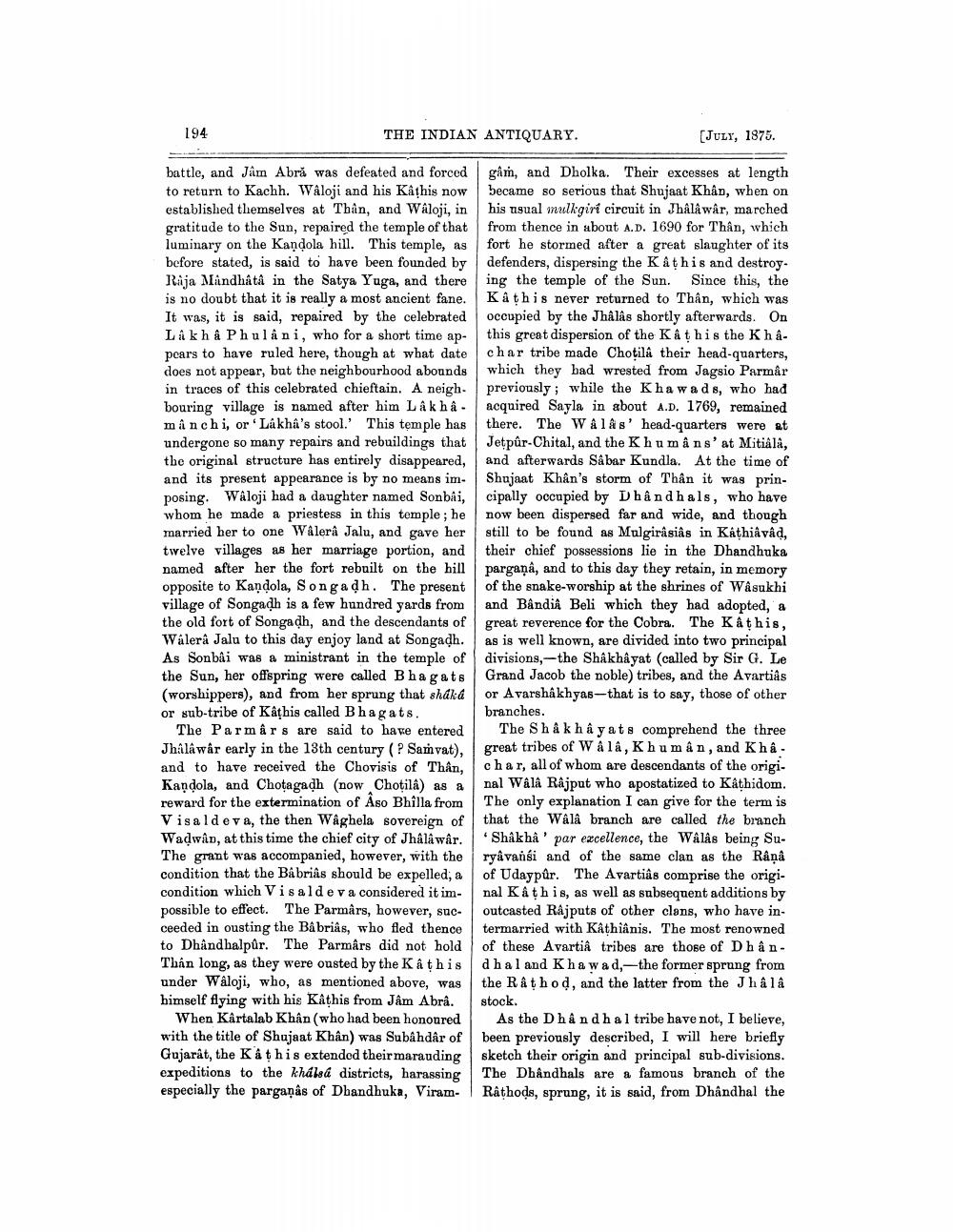________________
194
THE INDIAN ANTIQUARY.
battle, and Jâm Abra was defeated and forced to return to Kachh. Wâloji and his Kathis now established themselves at Thân, and Wâloji, in gratitude to the Sun, repaired the temple of that luminary on the Kandola hill. This temple, as before stated, is said to have been founded by Raja Mandhâtâ in the Satya Yuga, and there is no doubt that it is really a most ancient fane. It was, it is said, repaired by the celebrated Lakha Phulâ ni, who for a short time appears to have ruled here, though at what date does not appear, but the neighbourhood abounds in traces of this celebrated chieftain. A neigh. bouring village is named after him Lâkhâmânchi, or Lâkhâ's stool.' This temple has undergone so many repairs and rebuildings that the original structure has entirely disappeared, and its present appearance is by no means imposing. Wâloji had a daughter named Sonbâi, whom he made a priestess in this temple; he married her to one Wâlerâ Jalu, and gave her twelve villages as her marriage portion, and named after her the fort rebuilt on the hill opposite to Kandola, Songadh. The present village of Songadh is a few hundred yards from the old fort of Songadh, and the descendants of Walerâ Jalu to this day enjoy land at Songadh. As Sonbâi was a ministrant in the temple of the Sun, her offspring were called Bhagats (worshippers), and from her sprung that shaka or sub-tribe of Kâthis called Bhagats.
The Parmârs are said to have entered Jhâlâwâr early in the 13th century (? Samvat), and to have received the Chovisis of Thân, Kandola, and Chotagadh (now Chotila) as a reward for the extermination of Aso Bhilla from Visaldeva, the then Wâghela sovereign of Wadwan, at this time the chief city of Jhâlâwâr. The grant was accompanied, however, with the condition that the Bâbriâs should be expelled; a condition which Visalde va considered it impossible to effect. The Parmârs, however, succeeded in ousting the Bâbriâs, who fled thence to Dhandhalpûr. The Parmârs did not hold Thân long, as they were ousted by the Kâ this under Wâloji, who, as mentioned above, was himself flying with his Kâthis from Jâm Abrâ.
When Kartalab Khân (who had been honoured with the title of Shujaat Khân) was Subâhdâr of Gujarat, the K â this extended their marauding expeditions to the khálsá districts, harassing especially the parganâs of Dhandhuka, Viram
[JULY, 1875.
gâm, and Dholka. Their excesses at length became so serious that Shujaat Khân, when on his usual mulkgiri circuit in Jhâlâwâr, marched from thence in about A.D. 1690 for Thân, which fort he stormed after a great slaughter of its defenders, dispersing the K â this and destroying the temple of the Sun. Since this, the Kathis never returned to Thân, which was occupied by the Jhâlâs shortly afterwards. On this great dispersion of the K â this the Khâchar tribe made Choțilâ their head-quarters, which they had wrested from Jagsio Parmâr previously; while the Kha wads, who had acquired Sayla in about A.D. 1769, remained there. The Wâlâs' head-quarters were at Jetpûr-Chital, and the Khu mâns' at Mitiâlâ, and afterwards Sâbar Kundla. At the time of Shujaat Khân's storm of Thân it was principally occupied by Dhândhals, who have now been dispersed far and wide, and though still to be found as Mulgirâsiâs in Kathiâvâd, their chief possessions lie in the Dhandhuka parganâ, and to this day they retain, in memory of the snake-worship at the shrines of Wâsukhi and Bândia Beli which they had adopted, a great reverence for the Cobra. The Kâthis, as is well known, are divided into two principal divisions, the Shâkhâyat (called by Sir G. Le Grand Jacob the noble) tribes, and the Avartiâs or Avarshakhyas-that is to say, those of other branches.
The Shak hayats comprehend the three great tribes of W âlâ, Khu mân, and Khâchar, all of whom are descendants of the original Wâlâ Rajput who apostatized to Kathidom. The only explanation I can give for the term is that the Wâlâ branch are called the branch
Shakha' par excellence, the Wâlâs being Suryâvansi and of the same clan as the Rânâ of Udaypûr. The Avartiâs comprise the original Kâ this, as well as subsequent additions by outcasted Rajputs of other clans, who have intermarried with Kâthiânis. The most renowned of these Avartiâ tribes are those of Dhândhal and Khaw a d,-the former sprung from the Rathod, and the latter from the Jhâlâ stock.
As the Dhân dha l tribe have not, I believe, been previously described, I will here briefly sketch their origin and principal sub-divisions. The Dhândhals are a famous branch of the Rathods, sprung, it is said, from Dhåndhal the




